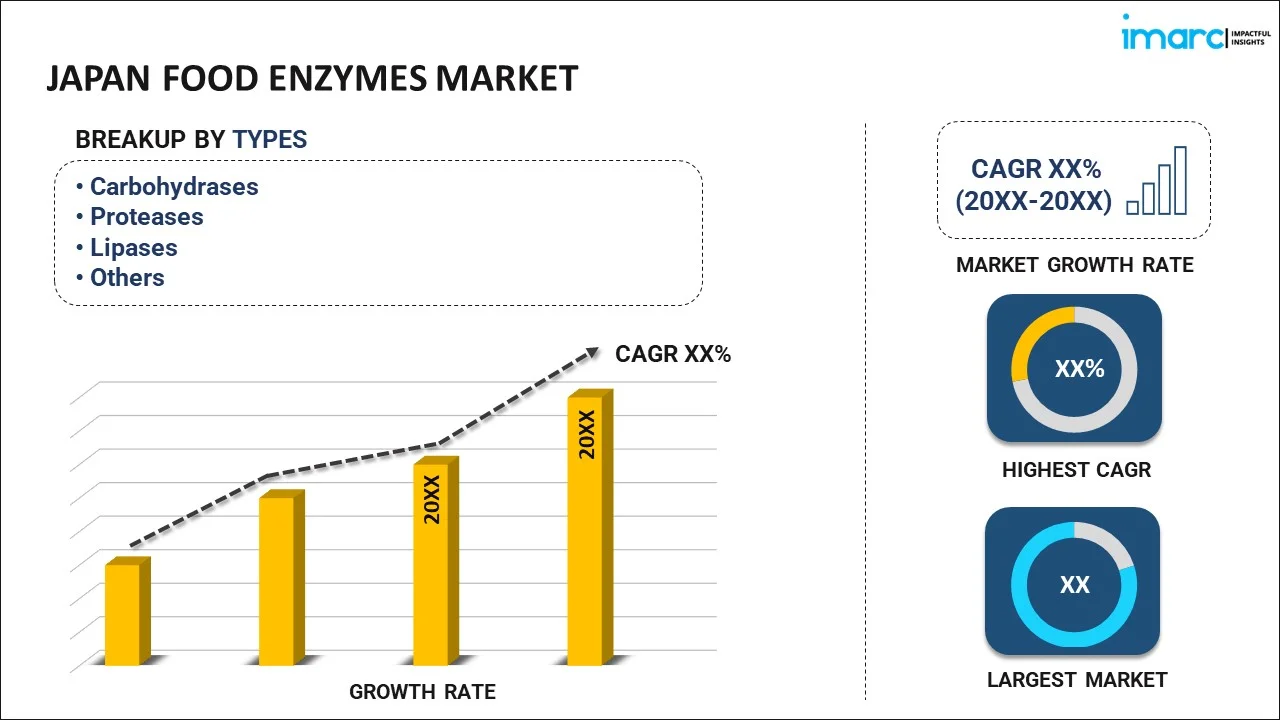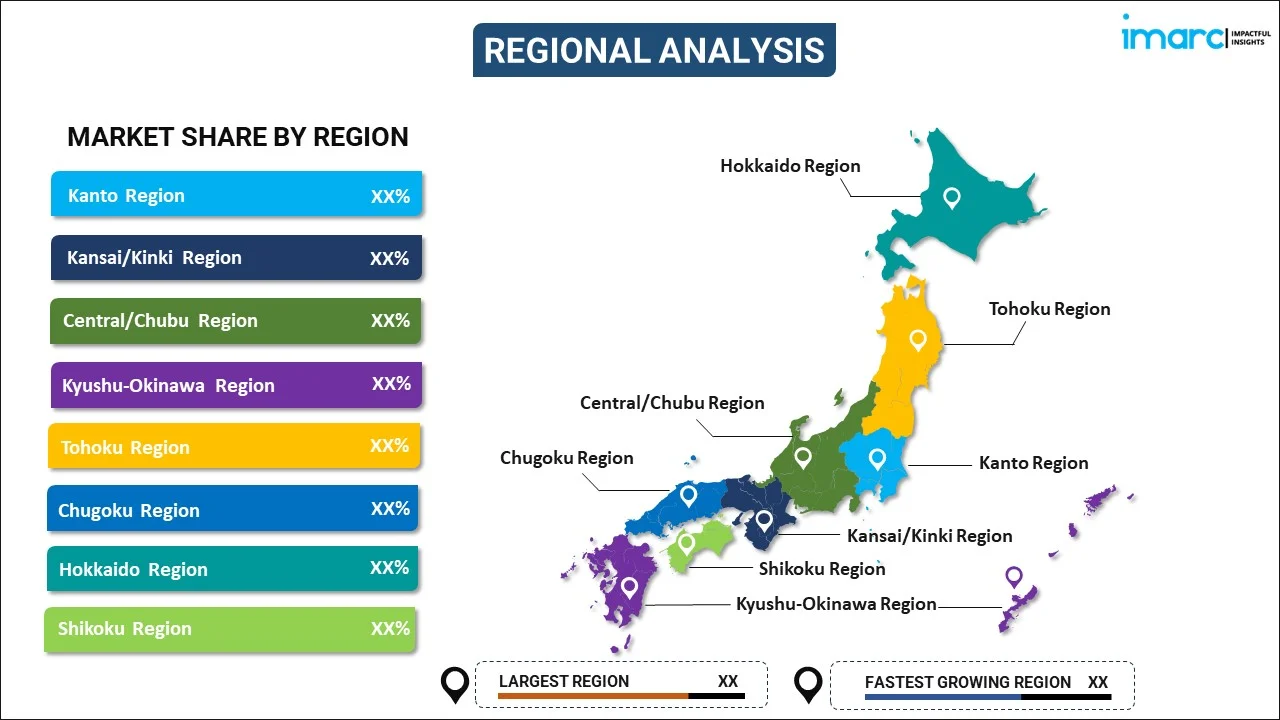
Japan Food Enzymes Market Report by Type (Carbohydrases, Proteases, Lipases, and Others), Application (Bakery, Confectionery, Dairy and Frozen Desserts, Meat Poultry and Sea Food Products, Beverages, and Others), and Region 2025-2033
Market Overview:
Japan food enzymes market size reached USD 153.4 Million in 2024. Looking forward, IMARC Group expects the market to reach USD 226.0 Million by 2033, exhibiting a growth rate (CAGR) of 4.18% during 2025-2033. The increasing consumer preferences for healthier foods and beverages, as well as ongoing efforts to reduce waste and enhance food safety through innovative enzyme technology, represent some of the key factors driving the market.
|
Report Attribute
|
Key Statistics
|
|---|---|
|
Base Year
|
2024 |
|
Forecast Years
|
2025-2033 |
|
Historical Years
|
2019-2024
|
| Market Size in 2024 | USD 153.4 Million |
| Market Forecast in 2033 | USD 226.0 Million |
| Market Growth Rate (2025-2033) | 4.18% |
Food enzymes are specialized proteins that serve as catalysts in various biochemical processes associated with food. They are naturally occurring in raw food and can also be intentionally incorporated during food processing to achieve specific objectives like enhancing flavor and texture as well as extending shelf life. These enzymes facilitate and accelerate chemical reactions that transform complex molecules into simpler, more readily digestible substances. Amylase, for example, aids in the breakdown of carbohydrates, protease targets proteins, and lipase is responsible for metabolizing fats. They are widely employed in the production of items like bread, cheese, and beverages, including beer and wine. Food enzymes are integral to modern food technology, significantly contributing to the overall quality and nutritional value of food products. By harnessing the power of these biological catalysts, the food industry can innovate and optimize various aspects of food production and processing, ultimately benefiting both producers and consumers.
Japan Food Enzymes Market Trends:
The food enzymes market in Japan is experiencing significant growth due to various factors, primarily driven by increasing consumer awareness of healthier food options. Consumers are now seeking nutrient-rich, high-quality foods and beverages, which has created a surge in demand for such products. This trend extends to alcoholic and non-alcoholic beverages, where food enzymes are crucial. These enzymes are essential for extracting juices from fruits and vegetables and are also employed in the wine industry for processes like clarification, filtration, and improving juice yields. Additionally, ongoing R&D initiatives that focus on waste reduction and enhance food safety are also creating a positive outlook for the market. Efforts are being made to develop newer, more efficient, and specialized enzymes to better catalyze various food-related processes. Furthermore, numerous advancements in biotechnology, which can facilitate the production of enzymes capable of withstanding diverse processing conditions, are expected to drive the market in Japan during the forecast period.
Japan Food Enzymes Market Segmentation:
IMARC Group provides an analysis of the key trends in each segment of the market, along with forecasts at the country level for 2025-2033. Our report has categorized the market based on type and application.
Type Insights:

- Carbohydrases
- Proteases
- Lipases
- Others
The report has provided a detailed breakup and analysis of the market based on the type. This includes carbohydrases, proteases, lipases, and others.
Application Insights:
- Bakery
- Confectionery
- Dairy and Frozen Desserts
- Meat Poultry and Sea Food Products
- Beverages
- Others
A detailed breakup and analysis of the market based on the application have also been provided in the report. This includes bakery, confectionery, dairy and frozen desserts, meat poultry and sea food products, beverage, and others.
Regional Insights:

- Kanto Region
- Kansai/Kinki Region
- Central/ Chubu Region
- Kyushu-Okinawa Region
- Tohoku Region
- Chugoku Region
- Hokkaido Region
- Shikoku Region
The report has also provided a comprehensive analysis of all the major regional markets, which include Kanto Region, Kansai/Kinki Region, Central/ Chubu Region, Kyushu-Okinawa Region, Tohoku Region, Chugoku Region, Hokkaido Region, and Shikoku Region.
Competitive Landscape:
The market research report has also provided a comprehensive analysis of the competitive landscape. Competitive analysis such as market structure, key player positioning, top winning strategies, competitive dashboard, and company evaluation quadrant has been covered in the report. Also, detailed profiles of all major companies have been provided.
Japan Food Enzymes Market Report Coverage:
| Report Features | Details |
|---|---|
| Base Year of the Analysis | 2024 |
| Historical Period | 2019-2024 |
| Forecast Period | 2025-2033 |
| Units | Million USD |
| Scope of the Report | Exploration of Historical Trends and Market Outlook, Industry Catalysts and Challenges, Segment-Wise Historical and Future Market Assessment:
|
| Types Covered | Carbohydrases, Proteases, Lipases, Others |
| Applications Covered | Bakery, Confectionery, Dairy and Frozen Desserts, Meat Poultry and Sea Food Products, Beverages, Others |
| Regions Covered | Kanto Region, Kansai/Kinki Region, Central/ Chubu Region, Kyushu-Okinawa Region, Tohoku Region, Chugoku Region, Hokkaido Region, Shikoku Region |
| Customization Scope | 10% Free Customization |
| Post-Sale Analyst Support | 10-12 Weeks |
| Delivery Format | PDF and Excel through Email (We can also provide the editable version of the report in PPT/Word format on special request) |
Key Questions Answered in This Report:
- How has the Japan food enzymes market performed so far and how will it perform in the coming years?
- What has been the impact of COVID-19 on the Japan food enzymes market?
- What is the breakup of the Japan food enzymes market on the basis of type?
- What is the breakup of the Japan food enzymes market on the basis of application?
- What are the various stages in the value chain of the Japan food enzymes market?
- What are the key driving factors and challenges in the Japan food enzymes?
- What is the structure of the Japan food enzymes market and who are the key players?
- What is the degree of competition in the Japan food enzymes market?
Key Benefits for Stakeholders:
- IMARC’s industry report offers a comprehensive quantitative analysis of various market segments, historical and current market trends, market forecasts, and dynamics of the Japan food enzymes market from 2019-2033.
- The research report provides the latest information on the market drivers, challenges, and opportunities in the Japan food enzymes market.
- Porter's five forces analysis assist stakeholders in assessing the impact of new entrants, competitive rivalry, supplier power, buyer power, and the threat of substitution. It helps stakeholders to analyze the level of competition within the Japan food enzymes industry and its attractiveness.
- Competitive landscape allows stakeholders to understand their competitive environment and provides an insight into the current positions of key players in the market.
Need more help?
- Speak to our experienced analysts for insights on the current market scenarios.
- Include additional segments and countries to customize the report as per your requirement.
- Gain an unparalleled competitive advantage in your domain by understanding how to utilize the report and positively impacting your operations and revenue.
- For further assistance, please connect with our analysts.
 Inquire Before Buying
Inquire Before Buying
 Speak to an Analyst
Speak to an Analyst
 Request Brochure
Request Brochure
 Request Customization
Request Customization




.webp)




.webp)












